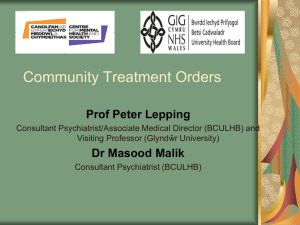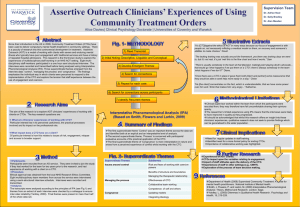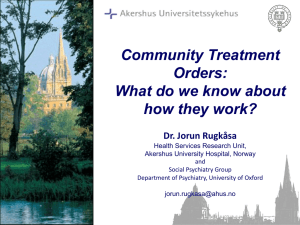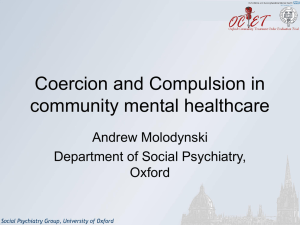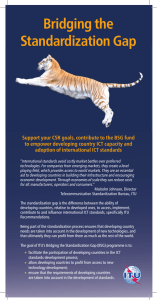Document 12892226
advertisement
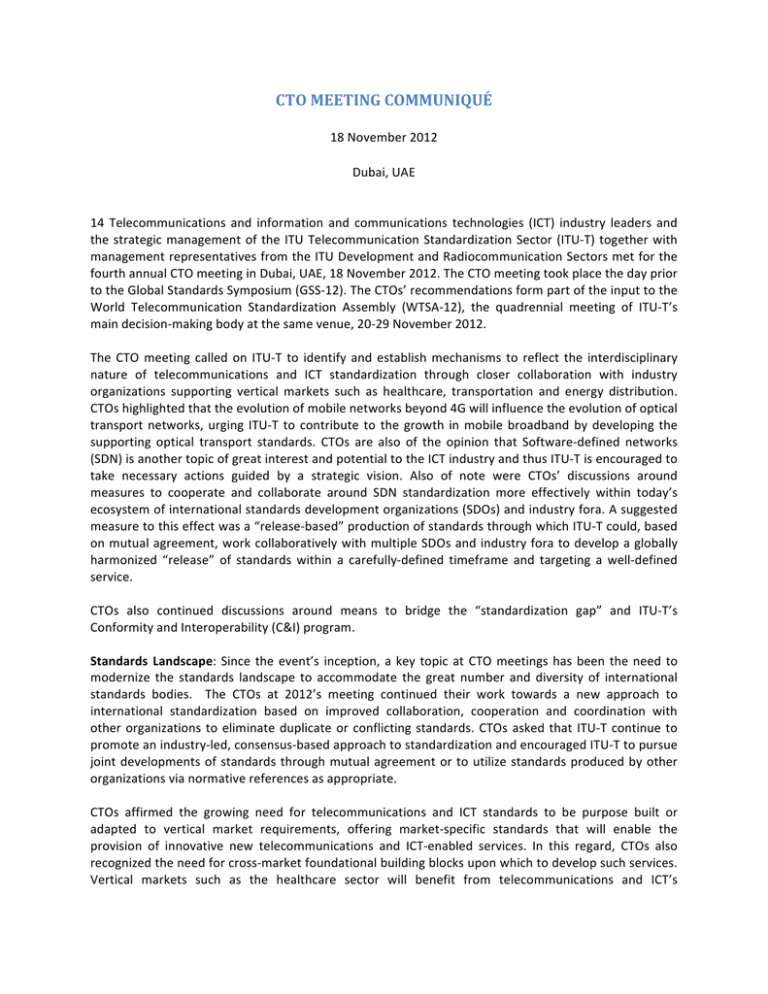
CTO MEETING COMMUNIQUÉ 18 November 2012 Dubai, UAE 14 Telecommunications and information and communications technologies (ICT) industry leaders and the strategic management of the ITU Telecommunication Standardization Sector (ITU-­‐T) together with management representatives from the ITU Development and Radiocommunication Sectors met for the fourth annual CTO meeting in Dubai, UAE, 18 November 2012. The CTO meeting took place the day prior to the Global Standards Symposium (GSS-­‐12). The CTOs’ recommendations form part of the input to the World Telecommunication Standardization Assembly (WTSA-­‐12), the quadrennial meeting of ITU-­‐T’s main decision-­‐making body at the same venue, 20-­‐29 November 2012. The CTO meeting called on ITU-­‐T to identify and establish mechanisms to reflect the interdisciplinary nature of telecommunications and ICT standardization through closer collaboration with industry organizations supporting vertical markets such as healthcare, transportation and energy distribution. CTOs highlighted that the evolution of mobile networks beyond 4G will influence the evolution of optical transport networks, urging ITU-­‐T to contribute to the growth in mobile broadband by developing the supporting optical transport standards. CTOs are also of the opinion that Software-­‐defined networks (SDN) is another topic of great interest and potential to the ICT industry and thus ITU-­‐T is encouraged to take necessary actions guided by a strategic vision. Also of note were CTOs’ discussions around measures to cooperate and collaborate around SDN standardization more effectively within today’s ecosystem of international standards development organizations (SDOs) and industry fora. A suggested measure to this effect was a “release-­‐based” production of standards through which ITU-­‐T could, based on mutual agreement, work collaboratively with multiple SDOs and industry fora to develop a globally harmonized “release” of standards within a carefully-­‐defined timeframe and targeting a well-­‐defined service. CTOs also continued discussions around means to bridge the “standardization gap” and ITU-­‐T’s Conformity and Interoperability (C&I) program. Standards Landscape: Since the event’s inception, a key topic at CTO meetings has been the need to modernize the standards landscape to accommodate the great number and diversity of international standards bodies. The CTOs at 2012’s meeting continued their work towards a new approach to international standardization based on improved collaboration, cooperation and coordination with other organizations to eliminate duplicate or conflicting standards. CTOs asked that ITU-­‐T continue to promote an industry-­‐led, consensus-­‐based approach to standardization and encouraged ITU-­‐T to pursue joint developments of standards through mutual agreement or to utilize standards produced by other organizations via normative references as appropriate. CTOs affirmed the growing need for telecommunications and ICT standards to be purpose built or adapted to vertical market requirements, offering market-­‐specific standards that will enable the provision of innovative new telecommunications and ICT-­‐enabled services. In this regard, CTOs also recognized the need for cross-­‐market foundational building blocks upon which to develop such services. Vertical markets such as the healthcare sector will benefit from telecommunications and ICT’s borderless transfer of information and access to education resources; the automotive industry from greener, safer intelligent transportation systems; and public utilities such as electricity and water from the efficiency gains enacted by smart electricity grids and smart water management. CTOs requested that ITU-­‐T engage and collaborate with SDOs and industry fora representing these vertical sectors, facilitating the participation of these stakeholders in ITU-­‐T’s work so as to ensure that SDOs work together in satisfying vertical sectors’ telecommunications and ICT standardization needs. CTOs acknowledged that broadband deployment is critical to providing e-­‐health solutions and encouraged ITU-­‐T to continue its collaboration with the World Health Organization (WHO) and other SDOs and industry fora in developing the international standards necessary to the expansion of secure, reliable and interoperable e-­‐health and telemedicine solutions. The CTO meeting identified the transportation and energy-­‐distribution sectors as other verticals in need of interoperable standards produced through efficient SDO and industry fora collaboration. Intelligent Transportation Systems (ITS) will deliver on their promise to reduce traffic congestion and greenhouse gas emissions only if ITS solutions are interoperable based on common standards. CTOs also pointed to Smart Grid as an emerging technology hinging its success on the availability of interoperable solutions based on robust international telecommunications and ICT standards. Improving the Effectiveness and Efficiency of Standards Delivery: Multiple SDOs and industry fora play complementary roles in certain standardization domains, but a lack of coordination in this work can slow systems’ delivery and adoption. A number of CTOs noted that growing markets such as cloud computing and machine-­‐to-­‐machine communications (M2M) could benefit from coordinated SDO action, and thus proposed that ITU-­‐T members study the feasibility of a “release-­‐based” production of standards in instances relying on the coordination of standardization work occurring in a number of bodies. CTOs stressed that this process would be based on mutual stakeholder agreement and clearly-­‐defined SDO roles. Given the broad nature of markets such as M2M and cloud computing, CTOs noted the importance of clearly defining the scope and requirements of each specific release. Recognizing that industry want to focus on greater efficiency in the creation of standards, the group considered a proposal that ITU take an active coordination role. ITU-­‐T’s role in this procedure would be to define a bulk “release” of standards on a topic, improving coordination with the related work of other SDOs and collaborating with these bodies to ensure a release’s coherence when issued and updated. The idea is a light but well-­‐defined process through which ITU-­‐T could quickly reference the work of other SDOs and thereby avoid duplication of work. It was recognized that ITU-­‐R’s methodology for developing the IMT (International Mobile Telecommunications) suite of standards is similar but would need to be more flexible. CTOs discussed the ITU-­‐T’s ongoing cloud computing work or the Focus Group on M2M Service Layer (FG-­‐M2M) work as potential pilots to ascertain the effectiveness of this approach. CTOs suggested that ITU-­‐T needs to have good collaboration with oneM2M and that a joint meeting between the FG-­‐M2M and oneM2M was noted as an option. Software-­‐defined Networking (SDN): CTOs identified SDN as a potential means to allow carrier networks to develop and deploy new services with great speed and flexibility. SDN was recognized as an innovative and perhaps also disruptive technology. SDN enables programmable interfaces to a network’s control and data planes, including capabilities such as network resource virtualization and network resource orchestration that can potentially optimize the use of network resources. CTOs noted ITU-­‐T’s current work and standards on network-­‐virtualization frameworks and architectures, and requested that ITU-­‐T continue exploring the applications of SDN in access networks, mobile backhaul, broadband network gateways, metro networks, and optical transport networks. The group recommended that ITU should take necessary actions guided by a strategic vision. Different possible approaches should be explored including the creation of a Focus Group specialized on SDN and continued activity in Question 21/SG13. The group recommended that ITU-­‐T (Study Group 13) should continue to concentrate on the architecture framework and in addition provide a gap analysis to examine what other work is being done (e.g. in other ITU-­‐T SGs and the Open Networking Foundation (ONF)) in order not to duplicate work and to collaborate where relevant. It was also recommended that ITU conduct a study on the impact of this technology for developing countries. ITU should also encourage the participation of academia. Transport as a key enabler for Mobile Broadband Beyond 4G: CTOs identified that the continuous growth of mobile networks beyond 4G will present the supporting optical transport network with a number of challenges. CTOs agreed that ITU-­‐T is well-­‐positioned to produce the standards needed to overcome challenges with respect to increased traffic (rate, latency, jitter) and high-­‐speed, synchronized transport for inter-­‐cell coordination and off-­‐site base band pooling. CTOs emphasized that optical infrastructure needs to be available to cell sites in order to enable B4G, and that future work in respect of transport and access standardization should acknowledge the evolution of mobile broadband as one of its key drivers. CTOs noted that this will only be achieved through the collaboration of players in the transport and access standardization ecosystem, and that this work requires the active participation of mobile operators in order to ensure that the requirements of real-­‐life deployment are taken into account. The group agreed that this issue should be brought to the attention of ITU-­‐T Study Group 15 Smartphone Security: CTOs discussed the need to bolster smartphone security mechanisms in light of the fact that smartphones store and transfer personal information and have become all-­‐purpose tools to communicate, navigate from place to place, browse the web or execute financial transactions. Recognizing that security is essential if smartphones are to continue offering innovative new services, CTOs noted that ITU-­‐T Study Group 17 and other SDOs, including GSMA, and industry fora in the mobile wireless industry are studying this topic and agreed to continue discussions regarding the need for smartphone security mechanisms. Noting that the ITU-­‐D has a very close relationship with regulators, which in turn have a key role in informing users of the possible dangers and consequences of using telecoms services it was agreed that the sector should take a role in sensitizing regulators to the issues via the Global Symposium for Regulators (GSR) and other mechanisms. Bridging the Standardization Gap: CTOs supported ITU-­‐T’s maintenance and expansion of its efforts to address the disparity between the standardization capacities of developed and developing countries. CTOs noted that industry has contributed much towards Bridging the Standardization Gap In this respect, CTOs recognized and supported ITU’s shift towards a market-­‐driven approach to interoperability testing, and noted that contributions by study group experts to the program would act to enhance the quality of the ITU-­‐T standards development process. (see also the TSAG reflector on C&I). Regulatory Impact on Telecommunications and Information and Communications Technologies (ICT) Development: CTOs suggested that ITU should consider the regulatory impact on telecommunications and ICT development and ask the Telecommunication Standardization Advisory Group (TSAG) to look at it in collaboration with ITU-­‐D. Participation at the fourth CTO Meeting Participants at the fourth CTO meeting in Dubai enjoyed constructive discussions, agreed a set proposed actions, and confirmed their resolve to meet regularly, scheduling their next meeting for the last quarter of 2013 along with the ITU Telecom meeting in Bangkok. The participating organizations were: Cisco Systems, Ericsson, Etisalat, Fujitsu, Huawei, KDDI, NEC, NSN, NTT, Orange FT, RIM, Telecom Italia, Telkom SA, Verizon, ITU Background to CTO Meetings CTO meetings are the product of ITU’s first Global Standards Symposium held in October 2008 (GSS-­‐08), which led 2008’s World Telecommunication Standardization Assembly (WTSA-­‐08) in Johannesburg to adopt Resolution 68 that requires ITU-­‐T to: “repeat the gathering of high-­‐level, private-­‐sector executives, along the lines of the GSS, but limited to the private sector, with the objective of strengthening the role of ITU-­‐T by responding to the needs of such high-­‐level executives in terms of their identified requirements and priorities for standardization activities within ITU-­‐T, in order to strengthen its role, also taking into consideration the needs of developing countries.” The first CTO meeting was held at ITU headquarters in Geneva, Switzerland, 6 October 2009; the second in Paris, 29 October 2010, hosted by France Telecom/Orange; and the third at the invitation of Mr. Malcolm Johnson, Director of the ITU Telecommunication Standardization Bureau (TSB), at the Palexpo Center in Geneva, 25 October 2011.
